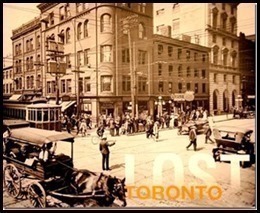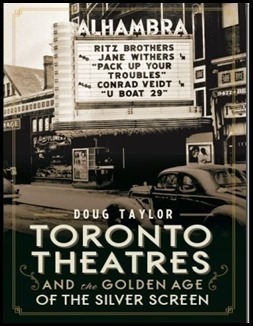I remember when the site of the Bell Lightbox, the headquarters of the Toronto International Film Festival (TIFF), was a parking lot. I also recall the excitement that occurred when they announced that a permanent home for the festival was to be built, designed by the architectural firm of Kuwbara Payne McKenna Blumberg (KPMB). Until it was completed, the festival’s offices were to remain in several different buildings in the downtown area. The new headquarters would allow TIFF’s support facilities to be located in a single structure. Another difficulty, prior to the construction of the new building, was that the screening venues for the festival were scattered from Bloor Street in the north to King Street in the south. Since the new headquarters was to be located in the heart of the city’s Entertainment District, it was hoped that the festival’s screening venues would eventually cluster around it. This did indeed occur.
After construction began, I anxiously watched the storeys rise, one after the other. Located at 350 King Street West, on Reitman Square, on the northwest corner of John and King Streets, it soon towered to a height of 46 floors. The name “Bell Lightbox” seemed appropriate, since Bell Corporation was a major financial contributor, and the word “lightbox” was an early-day name for a camera. The building opened on September 12, 2010, the 35th year since the inauguration of the festival, with a massive street party on King Street. Featuring live performers and concerts, it was a gala that lit the night until the early-morning hours.
The TIFF Lightbox occupies the five-storey podium of the 46-storey tower, its entire space dedicated to film—screening, archival, and educational. Above the Lightbox is a hotel/condo complex named the Festival Tower, set back from the street, with a separate entrance at 80 John Street. When sales commenced for the condos, rumours spread in the press and on the internet that Hollywood stars were purchasing condo units in the tower to provide accommodations and entertainment suites during the festival. However, the identity of the stars was kept a secret. These stories added to the mystery and glamour surrounding the building.
The TIFF Lightbox contains five cinemas, three studios, two restaurants, the Film Reference Library, a gift shop, two art galleries, a licensed lounge and a museum-quality display gallery. The members’ lounge is on the second floor, on the southeast corner of the building, with panoramic views of the street below where colourful streetcars ramble along the crowded avenue. The lobby is the equivalent of three storeys in height. An exceedingly tall escalator ascends from the lobby to the second floor. The south facade of the podium contains sheets of glass that during the day reflect the ever-changing panorama of historic King Street, and at night, its interior lights illuminate the streetscape like a giant beacon.
The theatres in the complex are among the most comfortable in the city. The rows are steeply-sloped to create stadium seating, ensuring that each seat possesses an unobstructed view of the screen. The Lightbox owns five types of 35 mm cameras, as well as one that is 70 mm.
I toured the building after it opened in 2010 and enjoyed the experience. However, I must admit that I had never attended the festival itself. I had resisted because I did not enjoy line-ups and did not wish to sit in a darkened theatre on a sunny late-summer day. However, in 2011, a friend had an extra ticket for a screening of a South Asian film at TIFF and offered it to me. I attended and thoroughly enjoyed the experience, particularly the discussion with the stars of the film following the screening. The next day, I purchased tickets to view a movie at the Elgin, and on arrival at the theatre, my friends and I were dismayed at the length of the line-up. However, when the doors opened, the lines entered within minutes. The organizational skills of the volunteers were amazing. My resistance to attending TIFF crumbled. I purchased a membership that I intended to use the following year.
Each year since, I have faithfully attended TIFF, and now consider it one of the highlights of my year. Several weeks prior to the festival, I purchase a package and choose the films I wish to see. I tend to avoid the popular Hollywood films as they will arrive in the regular theatres at some point following the festival. Instead, I concentrate on foreign movies and films that I might otherwise never have an opportunity to see. I choose mainly evening performances to enable me to continue enjoying September’s late-summer days. This approach works well for me, though it would not be everyone’s approach to choosing movies. I consider attending TIFF a wonderful experience. I am hooked.
The atmosphere on King Street during the festival is amazing. It’s wild, a kaleidoscope of colour and motion. While attending the various screenings, I have enjoyed conversations with strangers during the short waiting times before the theatre doors open. Inside the theatres, while waiting for the movies to begin, invariably people chat with me and share their opinions about films they have seen.
My visits to the Bell Lightbox are not restricted to when TIFF is in operation. I attend films there throughout the year. Viewing movies there is akin to attending a live theatrical performance, whether it is a movie classic from yesteryear, a foreign film, a recent Hollywood release or an art film. One evening I went to see a film about the painter Tom Thomson and was surprised to see that the theatre was full. It was gratifying to realize how much interest the famous artist generated.
On another occasion I viewed “2001 Space Odyssey,” viewing it as it was intended, with a 70 mm projector and Dolby sound. Another night a group of us saw the 1979-film “Love at First Bite.” The movie was corny and delightfully campy. Great fun! After the movie, the star of the film, George Hamilton, appeared and answered questions. The same group of friends also saw “Jaws,” and after viewing it on the big screen, we rediscovered what a terrifying film it was. The Bell Lightbox has become a regular haunt for my friends and me as it offers a wide range of films and experiences 365 days a year.
The Bell Lightbox is now an integral part of the Toronto scene. It participates in various events of the city. During the summer of 2012, the City of Toronto placed second-hand pianos throughout the downtown area and encouraged people to perform on them. Artists decorated the pianos, each one representing a country that would be participating in the 2015 Pan Am Games. The piano representing Costa Rica was in the lobby of the Bell Lightbox.
Toronto is greatly enriched by the presence of the Bell Lightbox, home to one of the world’s greatest film festivals.
The TIFF Lightbox and the Festival Tower Hotel/Condo above it during the summer of 2012. View gazes west on King Street.
The lobby of the Bell Lightbox from the second-floor level
Lobby of the Bell Lightbox during TIFF 2013, the red carpet visible.
The Bell Lightbox during 2012 TIFF
Entrance to the three-storey lobby of the Bell Lightbox
The south facade of the Bell Lightbox on King Street West
To view the Home Page for this blog: https://tayloronhistory.com/
For more information about the topics explored on this blog:
https://tayloronhistory.com/2016/03/02/tayloronhistory-comcheck-it-out/
Books by the Author
“ Lost Toronto”—employing detailed archival photographs, this recaptures the city’s lost theatres, sporting venues, bars, restaurants and shops. This richly illustrated book brings some of Toronto’s most remarkable buildings and much-loved venues back to life. From the loss of John Strachan’s Bishop’s Palace in 1890 to the scrapping of the S. S. Cayuga in 1960 and the closure of the HMV Superstore in 2017, these pages cover more than 150 years of the city’s built heritage to reveal a Toronto that once was.
“Toronto’s Theatres and the Golden Age of the Silver Screen,” explores 50 of Toronto’s old theatres and contains over 80 archival photographs of the facades, marquees and interiors of the theatres. It relates anecdotes and stories by the author and others who experienced these grand old movie houses. To place an order for this book, published by History Press:
Book also available in most book stores such as Chapter/Indigo, the Bell Lightbox and AGO Book Shop. (ISBN 978.1.62619.450.2)
“Toronto’s Movie Theatres of Yesteryear—Brought Back to Thrill You Again” explores 81 theatres. It contains over 125 archival photographs, with interesting anecdotes about these grand old theatres and their fascinating histories. Note: an article on this book was published in Toronto Life Magazine, October 2016 issue.
For a link to the article published by Toronto Life Magazine: torontolife.com/…/photos-old-cinemas-doug–taylor–toronto-local-movie-theatres-of-y…
The book is available at local book stores throughout Toronto or for a link to order this book: https://www.dundurn.com/books/Torontos-Local-Movie-Theatres-Yesteryear
“Toronto Then and Now,” published by Pavilion Press (London, England) explores 75 of the city’s heritage sites. It contains archival and modern photos that allow readers to compare scenes and discover how they have changed over the decades. Note: a review of this book was published in Spacing Magazine, October 2016. For a link to this review:
spacing.ca/toronto/2016/09/02/reading-list-toronto-then-and-now/
For further information on ordering this book, follow the link to Amazon.com here or contact the publisher directly by the link below:
http://www.ipgbook.com/toronto–then-and-now—products-9781910904077.php?page_id=21










![image_thumb6_thumb_thumb_thumb_thumb[2] image_thumb6_thumb_thumb_thumb_thumb[2]](https://tayloronhistory.com/wp-content/uploads/2018/09/image_thumb6_thumb_thumb_thumb_thumb2_thumb.png)


